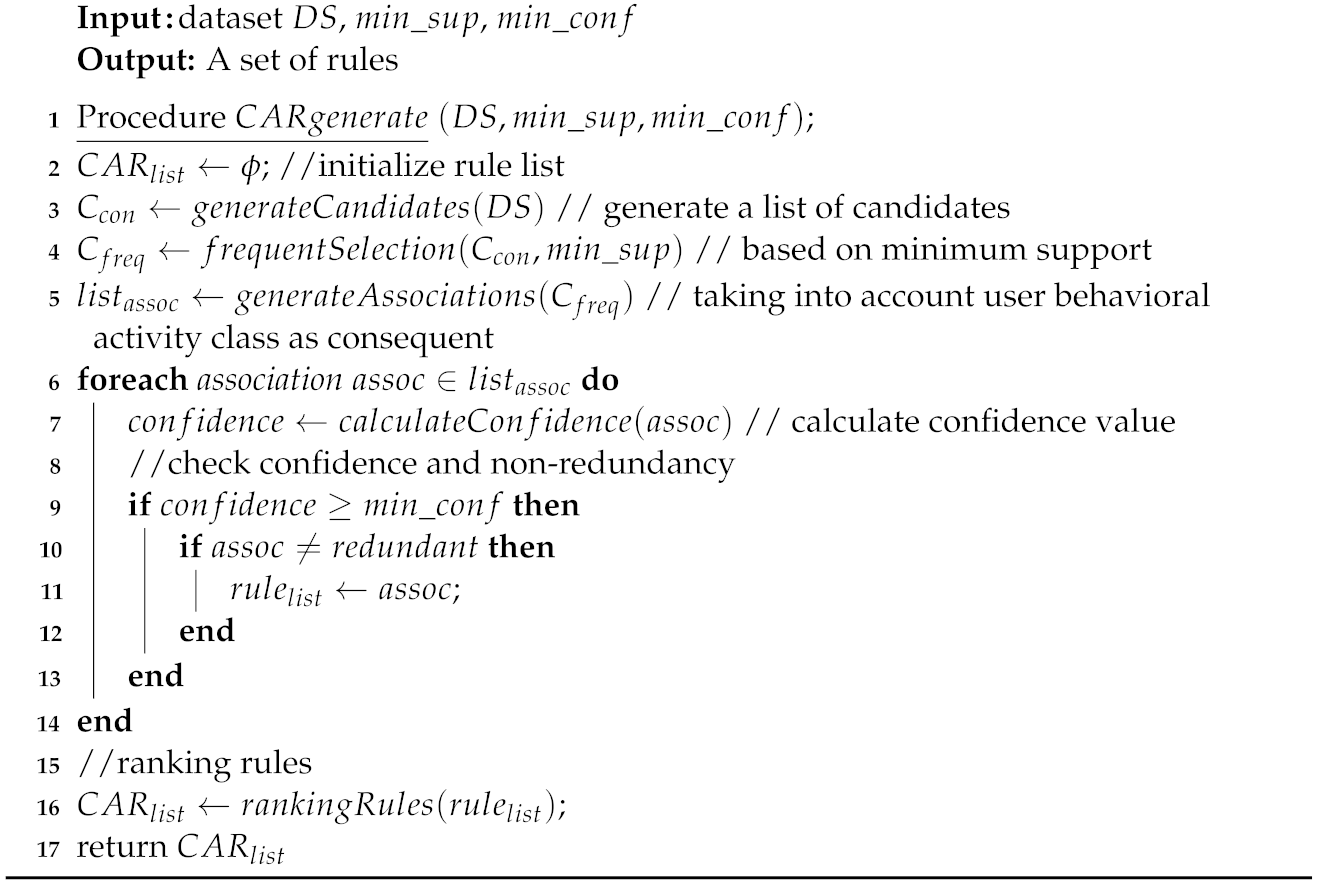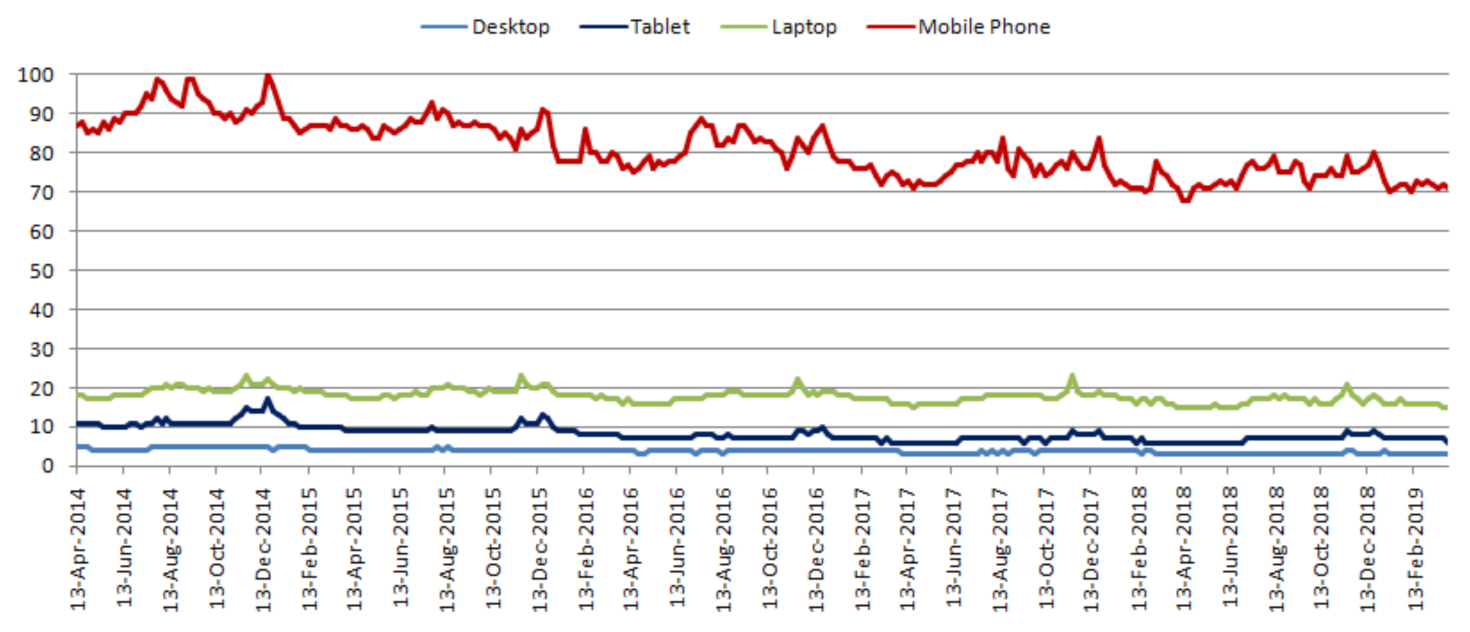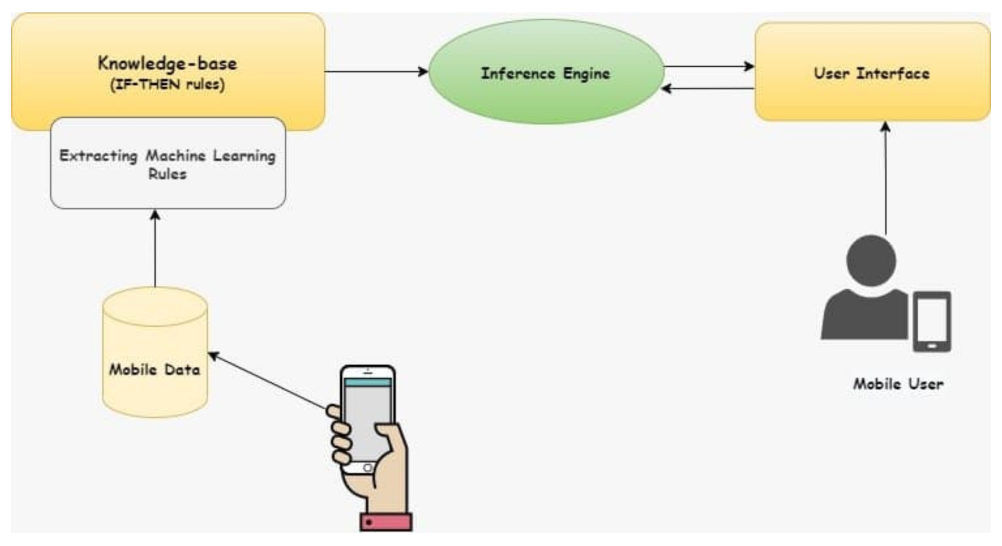Mobile Expert System: Exploring Context-Aware Machine Learning Rules for Personalized Decision-Making in Mobile Applications
Abstract
:1. Introduction
- To make personalized decisions, we take into account machine learning IF–THEN rules rather than human-generated hand-crafted rules;
- We design a mobile expert system modeling framework, where the automated IF–THEN rules generated by machine learning methods, are used as knowledge-base of the system, to build powerful mobile applications according to today’s needs;
- We use real mobile phone datasets to extract relevant rules based on multi-dimensional contexts and show how these rules may generate personalized decisions in a variety of context-aware test situations.
2. Background and Related Work
3. Mobile Expert System Modeling: Machine Learning Rule-Based Design
- Knowledge-base: In our mobile expert system modeling, this module is known as the “intelligence engine” for personalized decision making in which we are interested. It thus contains the knowledge of the target mobile application domain, as well as operational knowledge of the decision rules.
- Inference engine: The inference engine, which selects rules from the list to execute, is another processing module of the expert system. It seeks knowledge-based information and relationships and offers answers, forecasts, and recommendations the way a human expert might. In other words, the “knowledge-base” discussed earlier is used to conclude circumstances. Therefore, the main task of the inference engine is to find its way to a conclusion through a set of rules, discovered by Algorithm 1. To complete this, the method of forwarding chaining can be used, starting from the known facts and moving forward by applying rules of inference to obtain further data, and it continues until it reaches the target. Another method of backward chaining that begins from the goal can also be used according to the needs, going backward by using inference rules to decide the facts that match the goal.
- User interface: A user interface is a process by which a user is dealt with by the expert framework. This may be by dialogue boxes, prompts for orders, types, or other methods of input. Some advanced systems communicate with other computer programs and do not communicate directly with a human being. The expert system will provide an interaction method for transactions with the other program in these instances and will not have a user interface.
| Algorithm 1: Contextual association rule (CAR) generation. |
 |
4. Experimental Results and Discussion
4.1. Dataset Descriptions
4.2. IF–THEN Decision-Making Rules for Knowledge-Base
4.3. Effectiveness Analysis
5. Conclusions and Future Work
Author Contributions
Funding
Institutional Review Board Statement
Informed Consent Statement
Conflicts of Interest
References
- Peng, M.; Zeng, G.; Sun, Z.; Huang, J.; Wang, H.; Tian, G. Personalized app recommendation based on app permissions. World Wide Web 2018, 21, 89–104. [Google Scholar] [CrossRef]
- Sarker, I.H.; Hoque, M.M.; Uddin, M.K.; Alsanoosy, T. Mobile Data Science and Intelligent Apps: Concepts, AI-Based Modeling and Research Directions. Mob. Netw. Appl. 2020, 26, 285–303. [Google Scholar] [CrossRef]
- El Khaddar, M.A.; Boulmalf, M. Smartphone: The ultimate IoT and IoE device. In Smartphones from an Applied Research Perspective; 2017; p. 137. Available online: https://www.researchgate.net/publication/320907059_Smartphone_The_Ultimate_IoT_and_IoE_Device (accessed on 18 August 2021).
- Zheng, P.; Ni, L.M. Spotlight: The rise of the smart phone. IEEE Distrib. Syst. Online 2006, 7, 3. [Google Scholar] [CrossRef]
- Sarker, I.H. Context-aware rule learning from smartphone data: Survey, challenges and future directions. J. Big Data 2019, 6, 1–25. [Google Scholar] [CrossRef] [Green Version]
- Google Trends. 2019. Available online: https://trends.google.com/trends/ (accessed on 10 August 2021).
- Pejovic, V.; Musolesi, M. InterruptMe: Designing intelligent prompting mechanisms for pervasive applications. In Proceedings of the International Joint Conference on Pervasive and Ubiquitous Computing, Seattle, WA, USA, 13–17 September 2014; ACM: New York, NY, USA, 2014; pp. 897–908. [Google Scholar]
- Sarker, I.H. Data Science and Analytics: An Overview from Data-Driven Smart Computing, Decision-Making and Applications Perspective. SN Comput. Sci. 2021, 2, 377. [Google Scholar] [CrossRef]
- Sarker, I.H. Deep Learning: A Comprehensive Overview on Techniques, Taxonomy, Applications and Research Directions. SN Comput. Sci. 2021, 2, 1–20. [Google Scholar] [CrossRef]
- Sarker, I.H.; Furhad, M.H.; Nowrozy, R. Ai-driven cybersecurity: An overview, security intelligence modeling and research directions. SN Comput. Sci. 2021, 2, 1–18. [Google Scholar] [CrossRef]
- Sarker, I.H. Machine learning: Algorithms, real-world applications and research directions. SN Comput. Sci. 2021, 2, 1–21. [Google Scholar] [CrossRef]
- Zulkernain, S.; Madiraju, P.; Ahamed, S.I.; Stamm, K. A Mobile Intelligent Interruption Management System. J. UCS 2010, 16, 2060–2080. [Google Scholar]
- Pielot, M. Large-scale evaluation of call-availability prediction. In Proceedings of the International Joint Conference on Pervasive and Ubiquitous Computing, Seattle, WA, USA, 13–17 September 2014; ACM: New York, NY, USA, 2014; pp. 933–937. [Google Scholar]
- Knittel, J.; Sahami Shirazi, A.; Henze, N.; Schmidt, A. Utilizing contextual information for mobile communication. In Extended Abstracts on Human Factors in Computing Systems; ACM: New York, NY, USA, 2013; pp. 1371–1376. [Google Scholar]
- Smith, J.; Dulay, N. Ringlearn: Long-term mitigation of disruptive smartphone interruptions. In Proceedings of the International Conference on Pervasive Computing and Communications Workshops (PERCOM Workshops), Budapest, Hungary, 24–28 March 2014; pp. 27–35. [Google Scholar]
- Bohmer, M.; Lander, C.; Gehring, S.; Brumby, D.P.; Kruger, A. Interrupted by a phone call: Exploring designs for lowering the impact of call notifications for smartphone users. In Proceedings of the SIGCHI Conference on Human Factors in Computing Systems, Toronto, ON, Canada, 26 April–1 May 2014; ACM: New York, NY, USA, 2014; pp. 3045–3054. [Google Scholar]
- Grandhi, S.A.; Jones, Q. Knock knock whos there? Putting the user in control of managing interruptions. Int. J. Hum.-Comput. Stud. 2015, 79, 35–50. [Google Scholar] [CrossRef]
- Sahami Shirazi, A.; Henze, N.; Dingler, T.; Pielot, M.; Weber, D.; Schmidt, A. Large-scale assessment of mobile notifications. In Proceedings of the SIGCHI Conference on Human Factors in Computing Systems, Toronto, ON, Canada, 26 April–1 May 2014; ACM: New York, NY, USA, 2014; pp. 3055–3064. [Google Scholar]
- Mehrotra, A.; Hendley, R.; Musolesi, M. PrefMiner: Mining user’s preferences for intelligent mobile notification management. In Proceedings of the International Joint Conference on Pervasive and Ubiquitous Computing, Heidelberg, Germany, 12–16 September 2016; ACM: New York, NY, USA, 2016; pp. 1223–1234. [Google Scholar]
- Kanjo, E.; Kuss, D.J.; Ang, C.S. NotiMind: Utilizing Responses to Smart Phone Notifications as Affective sensors. IEEE Access 2017, 5, 22023–22035. [Google Scholar] [CrossRef]
- Turner, L.D.; Allen, S.M.; Whitaker, R.M. Push or delay? decomposing smartphone notification response behaviour. In Human Behavior Understanding; Springer: Berlin/Heidelberg, Germany, 2015; pp. 69–83. [Google Scholar]
- Zheng, V.W.; Cao, B.; Zheng, Y.; Xie, X.; Yang, Q. Collaborative Filtering Meets Mobile Recommendation: A User-Centered Approach. AAAI 2010, 10, 236–241. [Google Scholar]
- Kim, K.j.; Ahn, H.; Jeong, S. Context-aware recommender systems using data mining techniques. Proc. World Acad. Sci. Eng. Technol. 2010, 64, 357–362. [Google Scholar]
- Liu, Q.; Ge, Y.; Li, Z.; Chen, E.; Xiong, H. Personalized travel package recommendation. In Proceedings of the 2011 IEEE 11th International Conference on Data Mining, Vancouver, BC, Canada, 11–14 December 2011; pp. 407–416. [Google Scholar]
- Bobadilla, J.; Ortega, F.; Hernando, A.; Gutiérrez, A. Recommender systems survey. Knowl.-Based Syst. 2013, 46, 109–132. [Google Scholar] [CrossRef]
- Liu, B.; Kong, D.; Cen, L.; Gong, N.Z.; Jin, H.; Xiong, H. Personalized Mobile App Recommendation: Reconciling App Functionality and User Privacy Preference. In Proceedings of the 8th ACM International Conference on Web Search and Data Mining, Shanghai, China, 2–6 February 2015; ACM: New York, NY, USA, 2015; pp. 315–324. [Google Scholar]
- Zhu, H.; Chen, E.; Xiong, H.; Yu, K.; Cao, H.; Tian, J. Mining Mobile User Preferences for Personalized Context-Aware Recommendation. ACM Trans. Intell. Syst. Technol. (TIST) 2014, 5, 58. [Google Scholar] [CrossRef]
- Hong, J.; Suh, E.H.; Kim, J.; Kim, S. Context-aware system for proactive personalized service based on context history. Expert Syst. Appl. 2009, 36, 7448–7457. [Google Scholar] [CrossRef]
- Lee, W.P. Deploying personalized mobile services in an agent-based environment. Expert Syst. Appl. 2007, 32, 1194–1207. [Google Scholar] [CrossRef]
- Sarker, I.H. A machine learning based robust prediction model for real-life mobile phone data. Internet Things 2019, 5, 180–193. [Google Scholar] [CrossRef] [Green Version]
- Pielot, M.; De Oliveira, R.; Kwak, H.; Oliver, N. Didn’t you see my message? Predicting attentiveness to mobile instant messages. In Proceedings of the SIGCHI Conference on Human Factors in Computing Systems, Toronto, ON, Canada, 26 April–1 May 2014; ACM: New York, NY, USA, 2014; pp. 3319–3328. [Google Scholar]
- Freitas, A.A. Understanding the crucial differences between classification and discovery of association rules: A position paper. ACM Sigkdd Explor. Newsl. 2000, 2, 65–69. [Google Scholar] [CrossRef]
- Sarker, I.H.; Colman, A.; Han, J. RecencyMiner: Mining recency-based personalized behavior from contextual smartphone data. J. Big Data 2019, 6, 1–21. [Google Scholar] [CrossRef] [Green Version]
- Agrawal, R.; Srikant, R. Fast algorithms for mining association rules in Large Databases. In Proceedings of the International Joint Conference on Very Large Data Bases, Santiago, Chile, 12–15 September 1994; Volume 1215, pp. 487–499. [Google Scholar]
- Agrawal, R.; Imieliński, T.; Swami, A. Mining Association Rules between Sets of Items in Large Databases; ACM SIGMOD Record; ACM: New York, NY, USA, 1993; Volume 22, pp. 207–216. [Google Scholar]
- Srinivasan, V.; Moghaddam, S.; Mukherji, A. Mobileminer: Mining your frequent patterns on your phone. In Proceedings of the International Joint Conference on Pervasive and Ubiquitous Computing, Seattle, WA, USA, 13–17 September 2014; ACM: New York, NY, USA, 2014; pp. 389–400. [Google Scholar]
- Sarker, I.H.; Salim, F.D. Mining User Behavioral Rules from Smartphone Data through Association Analysis. In Advances in Knowledge Discovery and Data Mining, PAKDD-2018; Springer: Berlin/Heidelberg, Germany, 2018; pp. 450–461. [Google Scholar]
- Sarker, I.H.; Kayes, A. ABC-RuleMiner: User behavioral rule-based machine learning method for context-aware intelligent services. J. Netw. Comput. Appl. 2020, 168, 102762. [Google Scholar] [CrossRef]
- Eagle, N.; Pentland, A.S. Reality mining: Sensing complex social systems. Pers. Ubiquitous Comput. 2006, 10, 255–268. [Google Scholar] [CrossRef]
- Sarker, I.H.; Colman, A.; Kabir, M.A.; Han, J. Individualized Time-Series Segmentation for Mining Mobile Phone User Behavior. Comput. J. Oxf. Univ. 2018, 61, 349–368. [Google Scholar] [CrossRef]
- Sarker, I.H. Understanding the Role of Data-Centric Social Context in Personalized Mobile Applications. EAI Endorsed Trans. Context-Aware Syst. Appl. 2018, 5, 1–6. [Google Scholar] [CrossRef]
- Sarker, I.H.; Salah, K. Appspred: Predicting context-aware smartphone apps using random forest learning. Internet Things 2019, 8, 100106. [Google Scholar] [CrossRef] [Green Version]


| Rules | Context-Aware Association Rules | Confidence |
|---|---|---|
| Conf = 100% | ||
| Conf = 98% | ||
| Conf = 100% | ||
| Conf = 92% | ||
| Conf = 84% |
| Rules | Context-Aware Association Rules | Confidence |
|---|---|---|
| Conf = 100% | ||
| Conf = 100% | ||
| Conf = 91% | ||
| Conf = 88% | ||
| Conf = 80% |
Publisher’s Note: MDPI stays neutral with regard to jurisdictional claims in published maps and institutional affiliations. |
© 2021 by the authors. Licensee MDPI, Basel, Switzerland. This article is an open access article distributed under the terms and conditions of the Creative Commons Attribution (CC BY) license (https://creativecommons.org/licenses/by/4.0/).
Share and Cite
Sarker, I.H.; Khan, A.I.; Abushark, Y.B.; Alsolami, F. Mobile Expert System: Exploring Context-Aware Machine Learning Rules for Personalized Decision-Making in Mobile Applications. Symmetry 2021, 13, 1975. https://doi.org/10.3390/sym13101975
Sarker IH, Khan AI, Abushark YB, Alsolami F. Mobile Expert System: Exploring Context-Aware Machine Learning Rules for Personalized Decision-Making in Mobile Applications. Symmetry. 2021; 13(10):1975. https://doi.org/10.3390/sym13101975
Chicago/Turabian StyleSarker, Iqbal H., Asif Irshad Khan, Yoosef B. Abushark, and Fawaz Alsolami. 2021. "Mobile Expert System: Exploring Context-Aware Machine Learning Rules for Personalized Decision-Making in Mobile Applications" Symmetry 13, no. 10: 1975. https://doi.org/10.3390/sym13101975
APA StyleSarker, I. H., Khan, A. I., Abushark, Y. B., & Alsolami, F. (2021). Mobile Expert System: Exploring Context-Aware Machine Learning Rules for Personalized Decision-Making in Mobile Applications. Symmetry, 13(10), 1975. https://doi.org/10.3390/sym13101975







